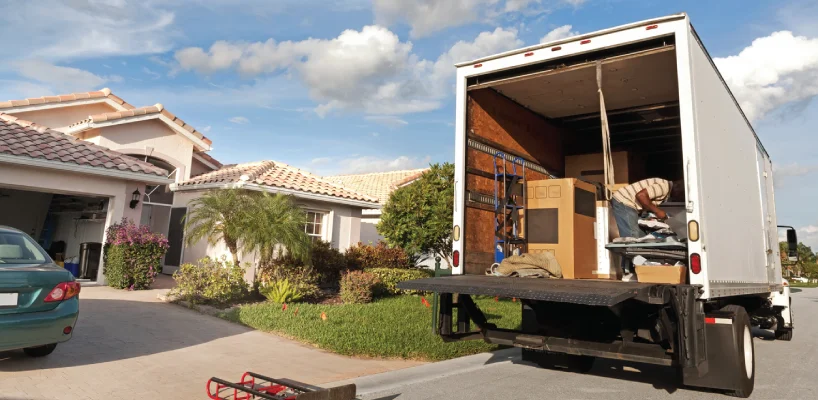Moving a refrigerator is no small feat. It can be one of the most challenging aspects of relocating. Unlike smaller household items, refrigerators are bulky, heavy, and contain delicate components that can be easily damaged if not handled properly.
The stakes are high: improper handling can lead to injuries, costly repairs, or even the need for a replacement refrigerator.
Whether you are moving to a new home or rearranging your kitchen, the process demands more than physical strength; it requires strategic planning and the right tools. From measuring pathways to securing doors, each step is crucial for a smooth move.
Let’s walk you through everything you need to know to safely and efficiently move your refrigerator.

The average weight of a refrigerator is between 200 to 300 pounds (90 to 136 kilograms), making it one of the heaviest household appliances to move.
Essential Equipment for Moving a Refrigerator
Moving a refrigerator requires careful planning and the right equipment to ensure safety and prevent damage. Here’s a list of essential equipment you’ll need:
| Equipment | Description |
|---|---|
| Appliance Dolly | Sturdy dolly for moving heavy refrigerators. |
| Furniture Straps | Straps the refrigerator to the dolly. |
| Moving Blankets | Blankets to protect the refrigerator from scratches. |
| Packing Tape/Stretch Wrap | Used to secure refrigerator doors and drawers. |
| Gloves | Heavy-duty gloves for hand protection. |
| Measuring Tape | Used to measure spaces to ensure the refrigerator fits. |
| Furniture Sliders | Sliders to move the refrigerator without floor damage. |
| Cardboard/Plywood Sheets | Protects floors and provides a smooth surface for moving. |
| Bungee Cords/Rope | Secures the refrigerator during transportation. |
| Ramp (for truck loading) | Helps load the refrigerator into a truck safely. |
| Screwdriver/Allen Wrench | Tools for disassembling if needed. |
Are you Curious about the most helpful moving equipment and how to use them?
How Much Does it Cost to Move a Refrigerator?
The cost of moving a refrigerator can vary depending on several factors such as distance, whether you hire professionals or do it yourself, and additional services required. Here's a general breakdown:
| Service Type | Cost Range | Details |
|---|---|---|
| DIY Moving | $5 - $100 | Cost of equipment like moving straps and dolly |
| Professional Moving | $100 - $500+ | Includes labor and transportation |
| Long Distance Moving | $300 - $1,000+ | Higher costs due to mileage |
Click and learn: Hand Truck Vs Dolly – Which One To Choose

Always use safe lifting techniques or equipment like dollies and straps to avoid injury when moving a refrigerator.
Steps to Move a Refrigerator
Moving a refrigerator requires careful planning and execution to ensure safety and prevent damage. Here are the essential steps to move a refrigerator:
Gather Supplies and Tools
- Moving Dolly: Ensure you have a sturdy appliance dolly that can handle the weight of your refrigerator.
- Moving Straps or Rope: To secure the refrigerator on the dolly and during transport.
- Cleaning Supplies: To clean the interior and exterior of the refrigerator before and after the move.
- Protective Gear: Wear gloves to protect your hands and safety goggles if needed.
Prepare the Refrigerator
- Empty the Contents: Remove all food items, shelves, and drawers from inside the refrigerator and freezer.
- Clean the Interior: Wipe down the interior surfaces with a mild cleaning solution and dry thoroughly.
- Defrost (if necessary): If your refrigerator has a freezer that collects ice, defrost it completely to avoid water leakage during the move.
Disconnect Utilities
- Unplug the Refrigerator: Disconnect the refrigerator from the power outlet.
- Disconnect Water Supply (if applicable): If your refrigerator has an ice maker or water dispenser, shut off the water supply and disconnect the water line.
Secure Movable Parts
- Secure Doors: Use tape or rope to secure the refrigerator doors shut. This prevents them from swinging open during transport.
- Secure Shelves and Drawers: Tape or tie down shelves and drawers inside the refrigerator to prevent them from shifting during the move.
Move the Refrigerator
- Position the Dolly: Place the dolly next to the refrigerator with its lifting plate close to the base.
- Slide the Refrigerator onto the Dolly: With the help of another person, carefully tilt the refrigerator onto the dolly and slide it into position.
- Secure the Refrigerator: Strap the refrigerator securely to the dolly to prevent it from tipping over during transport.
Transport the Refrigerator
- Maneuver Carefully: Use the dolly to carefully move the refrigerator to the moving truck or desired location.
- Watch the Pathway: Ensure the path is clear of obstacles and slippery spots to avoid accidents.
Unload and Install
- Positioning in the New Location: Carefully maneuver the refrigerator off the dolly and into its new position.
- Allow for Settling: Let the refrigerator sit upright for at least a few hours before plugging it back in to allow any oils or fluids to settle.
Final Checks
- Leveling: Use a level to ensure the refrigerator sits evenly on the floor.
- Plug in and Test: Once settled, plug the refrigerator back into the power source and check that it is cooling properly.
Dispose of Packing Materials and Clean Up
- Dispose of Packing Materials: Remove any tape, straps, or protective materials used during the move.
- Clean Up: Clean any debris or spills that occur during the moving process.
Post-Move Tips for Your Refrigerator
Here are some post-move tips to ensure your refrigerator is set up properly and functions correctly after the move:
| Tip | Description |
|---|---|
| Wait Before Plugging In | Let the refrigerator sit upright for 2-4 hours before plugging it in. |
| Inspect for Damage | Check for dents, scratches, and door issues. |
| Clean Inside | Wipe down the interior to remove dust and debris. |
| Level It | Ensure the refrigerator is level using the adjustable feet. |
| Reconnect Water Lines | Reconnect water lines if applicable and check for leaks. |
| Set Temperatures | Set the recommended temperatures: 37°F for the fridge and 0°F for the freezer. |
| Monitor Operation | Check for unusual noises and proper cooling. |
| Gradually Restock | Restock food gradually to allow for proper air circulation. |
| Check Door Seals | Ensure door seals are tight and free of gaps. |
| Dispose of Packing Materials | Properly dispose of or recycle packing materials. |
Looking for the move-out cleaning checklist?













































































































































 (239) 799–6077
(239) 799–6077